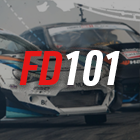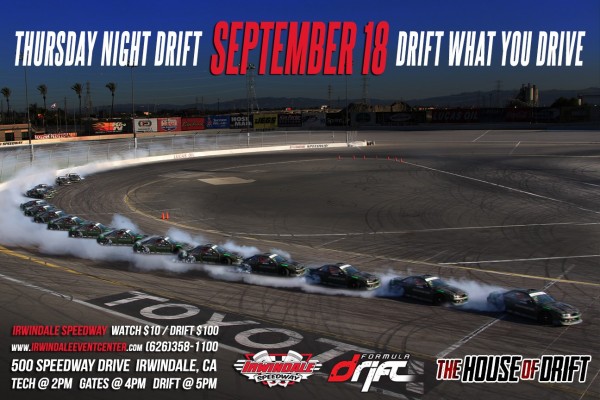
The 4th Irwindale Thursday Night Drift sessions will be tomorrow on September 18, 2014 will be open to the general public. Admission to the track’s grandstands will start at $10.00 including free parking. Gates will open at 2:00 PM. Drifting will start at 5:00 PM – 9:00 PM.
PRO Drivers that will be attending tomorrow will be:
Carl Rydquist
Hiro Sumida
Kyle Mohan
Dennis Mertzanis
Yosiki Yoshioka
Ken Gushi
Formula D Thursday Night Drift Schedule:
September 18
November 13
December 18
Ticket Prices:
$10.00 To Watch Drifting
$15.00 To Watch Drifting & Drag Racing
$100.00 To Drift
Schedule of Events:
2:00 PM – 10:00 PM – Venue Open
2:00 PM – 9:00 PM – TECH: All vehicles must pass tech before running
4:00 PM – 4:30 PM – MANDATORY: Drivers Meeting
5:00 PM – 9:00 PM – OPEN PRACTICE – Groups C,B,A
10:00 PM – CLEAR GRID (NOISE ORDINANCE; NO REVVING ENGINES)
What to expect at the track:
- Entry: When you enter the track, you’ll receive a tech card after paying your entry/participation fee. Entry will be limited to 40 vehicles, first come first serve.
- Tech: After receiving your tech card, you’ll drive your vehicle to Tech, where a simple safety inspection will be performed on your car.
- Staging lanes: Once you have passed Tech, drive to the rear of the staging lane with your Group A, B, or C and get ready to drift.
- Drifting: When it’s time for you to enter the course, an official will motion to you to pull up and then allow you go on course. At the end of your run, slow down and exit the track properly.
- Return to the staging lanes and get ready for your next run. We will alternate between groups throughout the evening.
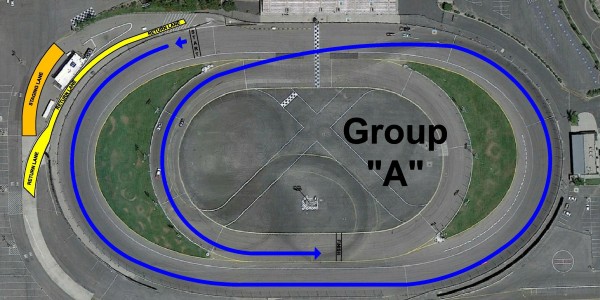
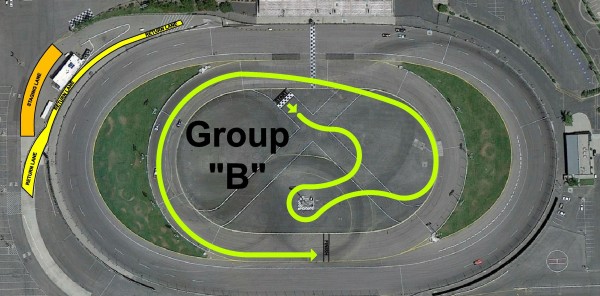
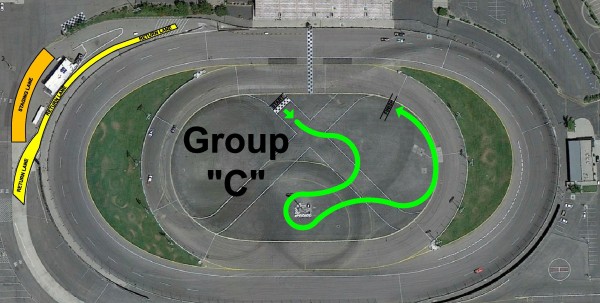
Driver Groups:
This section explains the different driver groups we have at all amateur events. Drivers are broken into Groups A, B, and C based on experience. Driving in the right group gives you and all of the other drivers in the group the best experience on track. Trying to drive in a group that you are not ready for is dangerous and will not happen.
Group A is for the drivers that have all the required safety equipment, meaning fire suit, shoes, gloves, appropriate roll cage, etc. These are the guys that have no issues making it around the track and are working on getting closer to other cars and running a better, faster line. Just because you have a roll cage does not put you in Group A.
Group B is for the drivers who are making it through the course without issues, i.e. not spinning, not understeering. They are running a good line; it may not be the best line, but they are learning. They are starting to go faster and trying new things. Though they may have the right safety equipment for tandem, but their skill set is not up to the level just yet.
Group C is for the new guys. They may still be learning about their cars, the track, etc. This is where everyone starts. There’s nothing wrong with being in Group C – we were all there. These are the guys who are working to link the course and beginning to understand what the right line is. They are figuring out what they need to do in the car to make a good run.
Driver Requirements
- Aclosedfacehelmetisrequired.SA2010isrequired.SA2005isallowedifthe manufactured date is after 3/2008 and is clearly marked on the helmet. The helmet must be in good condition and show no signs of damage. A chinstrap must be present and fastened. Open face helmets are not allowed. M helmets are not allowed. DOT helmets are not allowed.
- All drivers are required to wear long pants, closed-toe shoes and sleeved shirts. Long sleeved shirts are not required.
- The pit area must be kept clean of all trash at the end of an event. All used tires must be taken with you at the end of the event.
- If you spill any automotive fluids, you must clean it up immediately and notify track staff of any spills. Most of the tracks that we operate at have facilities for the disposal of automotive fluid. DO NOT dispose of any motor oil, antifreeze, or gear oil in the trashcans.
- Drivers must be 18 or older and possess a valid driver’s license. If under 18, parent or legal guardian must be present and sign a waiver.
- Drivers’ meetings are mandatory. If you do not attend the drivers’ meeting without making prior arrangements, you will not be allowed on track.
- Passengers are not allowed in cars on track. If a driver brings a passenger, they will be sent directly off track and can return to the back of the line after they drop off their passenger .
- Please use common sense in the pit and grid areas.
- Pit speed is 5 mph.
- Revving of engines and burnouts while not on course will not be tolerated.
- Drivers must be ready when their group is called. Time will not be extended if you did not get to run.
- Drivers must pay very close attention to all flaggers and course workers. If any of their instructions are ignored, the driver will be, at a minimum, kicked off track for the session. If the offense is repeated or unsafe, the driver will be ejected from the event.
- Failure to follow the rules or any instruction from racetrack staff will result in immediate ejection from the event and, depending on severity of offense, cause you to be banned from future events.
Group C Vehicle Requirements General Safety
- General vehicle inspection may include inspection of brakes, suspension, engine, drivetrain, and chassis for proper operation, condition and potential issues.
- Everything loose in the car must be removed, including floor mats, dirty clothes, old cd cases, cans, and anything else that might be floating around in your car. Dispose of all trash in track-provided garbage cans.
- Fire extinguishers are required for all cars. The fire extinguisher must be securely mounted within reach of driver while seated with the harness on. Minimum 2lb required. NO SHARING WITH FRIENDS; YOU MUST HAVE YOUR OWN.
Engine/Drivetrain
- No fluids can be leaking or dripping from the car. If signs of a fluid leak are present, evidence must be shown that leak no longer exists.
- A heat shield is required around the brake and clutch master cylinders for any cars with the exhaust side of the engine on the same side as the driver. OE heat shield is acceptable. Bent up license plates or other painted/coated surfaces are not acceptable.
- Coolant overflow is required on all cars. Oil overflow is required on cars that have removed or modified OE oil recovery system.
- A gas cap must be present and completely sealed. A firewall is required for all fuel system components inside the driver’s compartment. Stainless steel braided lines can pass through driver’s compartment, but all fittings and unions must be behind firewall or similarly shielded.
- All fluid hoses must be the proper hose for its intended application. Hose must have correct material and construction. Rubber hose should show no signs of wear or weak spots. All fuel hoses must use fuel line clamps; worm gear clamps are not allowed on fuel lines.
- Exhaust must be present and below 100db.
Lighting and Electrical
- Battery must be securely tied down with plastic or metal strap and proper hardware. No bungee cord, zip ties, etc.
- If battery is located in driver’s compartment, battery must be sealed and non-venting. Non-sealed batteries are allowed in driver’s compartment if in a fully sealed box, properly mounted, and vented outside the car.
- Brake lights must be operational. At least 2 brake lights must come on when using brake pedal.
- OE key must completely shut off car immediately. If OE key assembly is not used, a kill switch must be used to immediately shut off car. It needs to be easily accessible from outside the car, and the location needs to be clearly marked.
- All wiring should be protected, insulated, and properly mounted.
Suspension
- Ball joints and suspension bushings must be in good condition and have no excessive play or clunking.
- Wheel bearings must have zero play.
- Steering must be smooth in operation and exhibit no binding.
- All lug nuts must be present and properly torqued and have proper thread engagement. If using bolt-on spacers, all lugs nuts attaching the spacer to the hub must be present.
Body and Glass
- Body panels are required. Body panels include fenders, hood, and hatch/trunk. Due to the nature of drifting, bumpers and side skirts are not required at all times, although they are highly recommended.
- Tow hooks/straps are required in the front and rear. Factory tow hooks are allowed as long as the driver accepts that their car may be damaged when being towed. Tow hooks/straps should be easily found and painted a highly visible color and/or their location marked. Soft tow straps are recommended.
- Hood and trunk must be securely latched either using the OE latch or aftermarket pins or latches.
- Windshield, rear window, and fixed side windows must be present. Door windows must be operational if installed. Lexan or similar shatter resistant polycarbonate can be used. Windshield needs to be 3/16″ thick. Windshield must have center supports and must be bolted or riveted through the window frame. Spacing is a maximum of 12″ and there must be at least 4 fasteners on each side. Side and rear windows need to be 1/8″ thick.
Roll Cage
- Aftermarket roll bar, at a minimum, is required for all convertibles for road and oval course events. For parking lot events, if no roll bar is present, the roof must be up and properly fastened.
- A 6-point roll cage with harness bar and door bars is required for Group A.
- Roll cage must have X or NASCAR bars on both front doors.
- The roll cage must have diagonal in main hoop extending from above driver’s head to passenger floor, and the harness bar must extend the full length of the main hoop and be positioned for proper harness mounting.
- Rear mounting bars must tie in at the rear shock tower.
- Front cage design can be halo or a-pillar bars. Roof bar is required if using a-pillar bars.
- Dash bar is recommended but not required.
- Minimum tubing specification for all cars is 1.5”x0.095 DOM SAE 1018.
- For bolt-in cages, OE crash structure cannot be removed or modified. Ebay or “Tuner” bolt-in cages are not sufficient for tandem.
- Roll bar padding is required wherever the driver or passenger may come incontact with the roll cage, i.e. halo, door bars, lower a-pillar bar. Roll bar padding must be SFI rated. No pool noodles, home depot pipe insulation, etc.
Harnesses and Seats
- Harnesses must be properly mounted and not expired. Harnesses must be FIA or SFI rated and within the date range specified on the belts.
- Harnesses must be mounted using correct hardware. If using eye bolts and bolting through the floor, fender washers must be used on both sides to spread the load. Harness shoulder straps must be mounted to a roll cage or separate harness bar and should not be outside of 20° of horizontal. The seat cannot be used as a guide for the harness. No harness mounting points can be attached to the seat or seat rails; they must be attached to the chassis.
- If car does not have a roll cage, a harness bar can be used to mount the shoulder belts when using a 5- or 6-point harness. Must meet mounting requirements listed in item 2.
- 5- or 6-point harness is required for car with a roll cage installed.
- If harnesses are not properly installed and in compliance with FIA or SFI specifications, you will not be allowed to drive until this rule can be met.
- Please refer to manufacture specs for proper installation and maintenance procedures.
- If stock seats or non-FIA approved reclining bucket seats are used, a stock seat belt must be used. Aftermarket harnesses are not allowed to be used with these seats.
- If race seats are intended to be used with stock seat belt, the lap belt part of the seat belt must pass through the holes in the side of the race seat.
Group B Vehicle Requirements
- These requirements are in addition to the Group C Vehicle Requirements listed above.
- Car must have coilovers or similarly designed suspension setup. Lowering springs are not allowed.
- No VLSD’s or factory diffs allowed. Clutch type or welded diff required.
- All cars must have a working e-brake. Can be OE cable type or aftermarket hydraulic.
Group A Requirements
- These requirements are in addition to the Group C and B Vehicle Requirements listed above.
- A 6-point roll cage with harness bar and door bars is required for Group A.
- Roll cage must meet all rules listed in Roll Cage section above.
- SFI 3-2A/5 suit recommended. Minimum of SFI 3-2A/1 suit with full Nomexunderwear required. Shoes and gloves must be fire resistant.
Remember, drifting is fun. These rules and requirements are in place so that we can ensure a safe environment for having fun. All rules must be met in order to participate in the events. Anything found to be unsafe or questionable by tech inspectors will be reviewed by staff. If deemed unsafe, the car will not be allowed to run. The decision will be final. No exceptions will be made at the event. No refunds will be given for lost track time due to inability to meet these requirements. If there are any questions or concerns, please contact us prior to the event at the email address listed below.
Technical Inquiries: [email protected]
